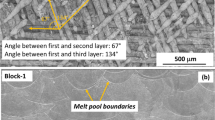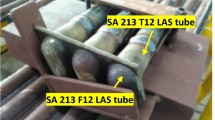Abstract
In the present investigation, joining speed, laser power and stand-off distance were took up as joining process parameters in determining the laser transmission joining between PET films and 316 L stainless steel plates. The laser transmission joining process parameters were optimized using response methodology for obtaining maximum joint width. The Box-Behnken Design has been used to plan the experiments and response surface methodology (RSM) is selected to develop mathematical relationships between joining parameters and desired response (joint width). From the ANOVA (analysis of variance) it was concluded that stand-off distance is contributing more and it is followed by joining speed and laser power. In the range of process parameters, the result shows that joining speed increases, joint width decreases, while with the increase of laser power and stand-off distance, joint width increases. Optimum values of joining speed, laser power and stand-off distance was found to be 100 mm/min, 18 watt and 3 mm to get the maximum joint width (Predicted 2.232 mm). Corresponding average tensile strength of joint was found to be 84.38 MPa. There was approximately 6.61 % error in the experimental and modeled results of joint seam width.










Similar content being viewed by others
References
X. Wang, X. Song, M. Jiang, P. Li, Y. Hu, K. Wang, H. Liu, Modeling and optimization of laser transmission joining process between PET and 316 L stainless steel using response surface methodology, Opt. Laser Technol. 44, 656–663 (2012).
X. Wang, C. Zhang, K. Wang, P. Li, Y. Hu, K. Wang, H. Liu, Multi-objective optimization of laser transmission joining of thermoplastics, Opt. Laser Technol. 44, 2393–2402 (2012).
B. Acherjee, A. S. Kuar, S. Mitra, D. Misra, Modeling of laser transmission contour welding process using FEA and DoE, Opt. Laser Technol. 44, 1281–1289 (2012).
H. Liu, K. Wang, P. Li, C. Zhang, D. Du, Y. Hu, X. Wang, Modeling and prediction of transmission laser bonding process between titanium coated glass and PET based on response surface methodology, Opt. Lasers Eng. 50, 440–448 (2012).
S.-T. Yang, W.-S. Hwang, T.-W. Shyr, Reverse transformation from α’ to γ in lightly and heavily cold-drawn austenitic stainless steel fibers, Met. Mater. Int. 19, 1181–1185 (2013).
S. Perrin, L. Marchetti, C. Duhamel, M. Sennour, F. Jomard, Influence of Irradiation on the Oxide Film Formed on 316 L Stainless Steel in PWR Primary water, Oxi. Met. 80, 623–633 (2013).
R. S. de Camposinhos, Stainless Steel and Aluminium Anchors. Stone Cladding Engineering, 155–167 (2014).
X. Wang, H. Chen, H. Liu, P. Li, Z. Yan, C. Huang, Z. Zhao, Y. Gu, Simulation and optimization of continuous laser transmission welding between PET and titanium through FEM, RSM, GA and experiments. Opt. Lasers Eng. 51, 1245–1254 (2013).
F. I. Hussein, E. Akman, B. GencOztoprak, M. Gunes, O. Gundogdu, E. Kacar, K. I. Hajim, A. Demir, Evaluation of PMMA joining to stainless steel 304 using pulsed Nd: YAGlaser. Opt. Laser Technol. 49, 143–152 (2013)
S. Sharma, Erosive Wear Study of Rare Earth Modified HVOF Sprayed Coatings Using Design of Experiment. J. Therm. Spray Technol. 21(1), 49–62 (2012)
M. D. F. Khan, D. K. Dwivedi, S. Sharma, Development of Response Surface Model for Tensile shear strength of weld-bonds of aluminium alloy 6061 T651. Mater. Des. 34, 673–678 (2012)
S. P. Dwivedi, S. Kumar, A. Kumar, Effect of Turning parameters on surface roughness of A356/5 % SiC composite produced by electromagnetic stir casting. J. Mech. Sci. Technol. 26(12), 3973–3979 (2012).
X. Wang, P. Li, Z. Xu, X. Song, H. Liu, Laser transmission joint between PET and titanium for biomedical application. J. Mater. Process. Technol. 210, 1767–1771 (2010)
Author information
Authors and Affiliations
Corresponding author
Rights and permissions
About this article
Cite this article
Dwivedi, S.P., Sharma, S. & Singh, V. Optimization of laser transmission joining process parameters on joint width of PET and 316 L stainless steel joint using RSM. J Opt 45, 106–113 (2016). https://doi.org/10.1007/s12596-016-0335-4
Received:
Accepted:
Published:
Issue Date:
DOI: https://doi.org/10.1007/s12596-016-0335-4




